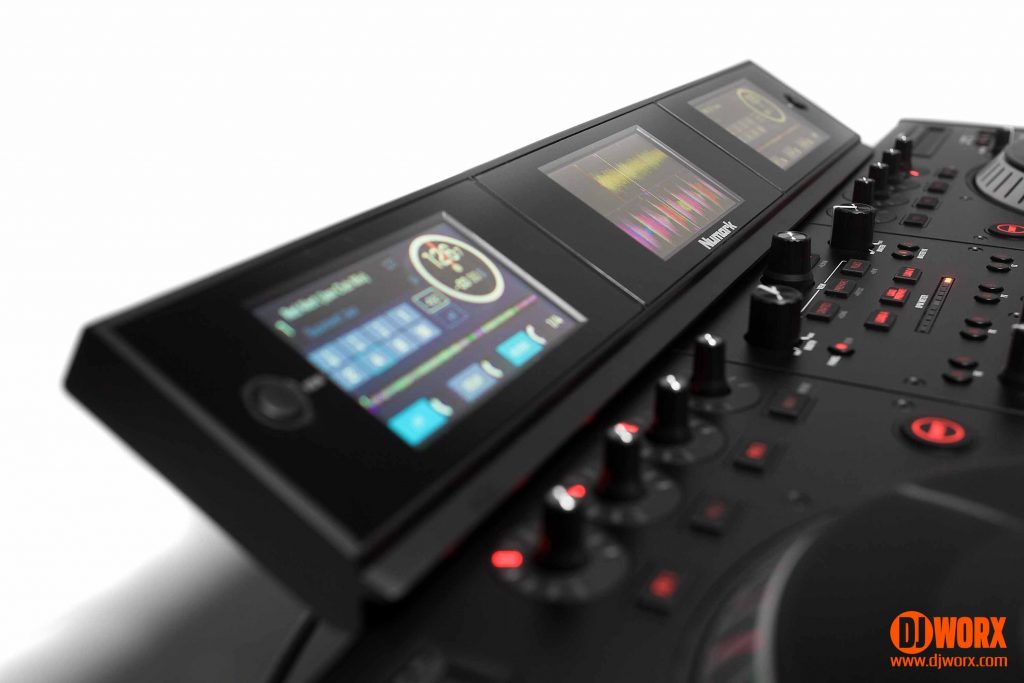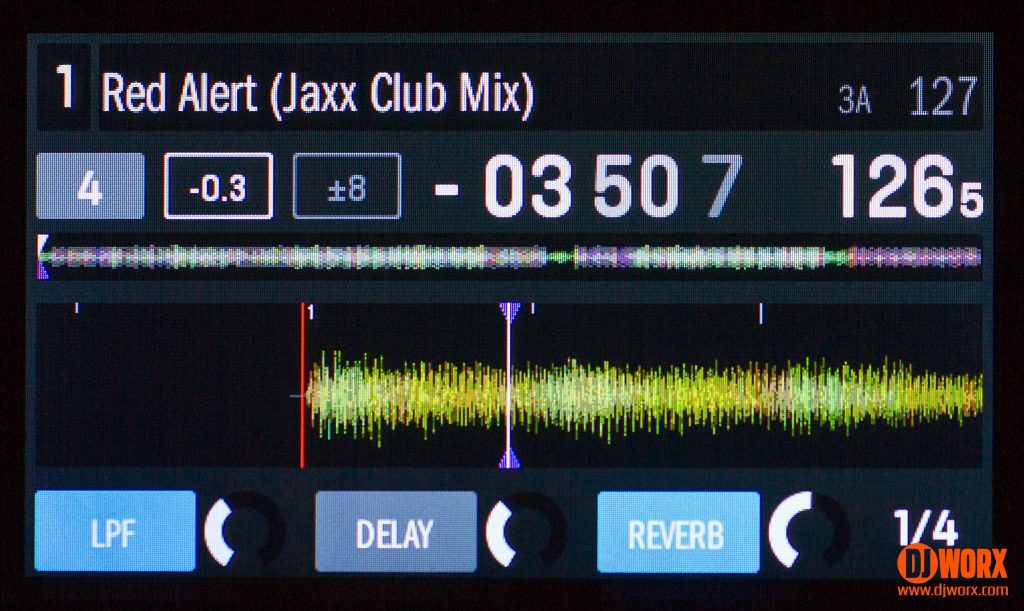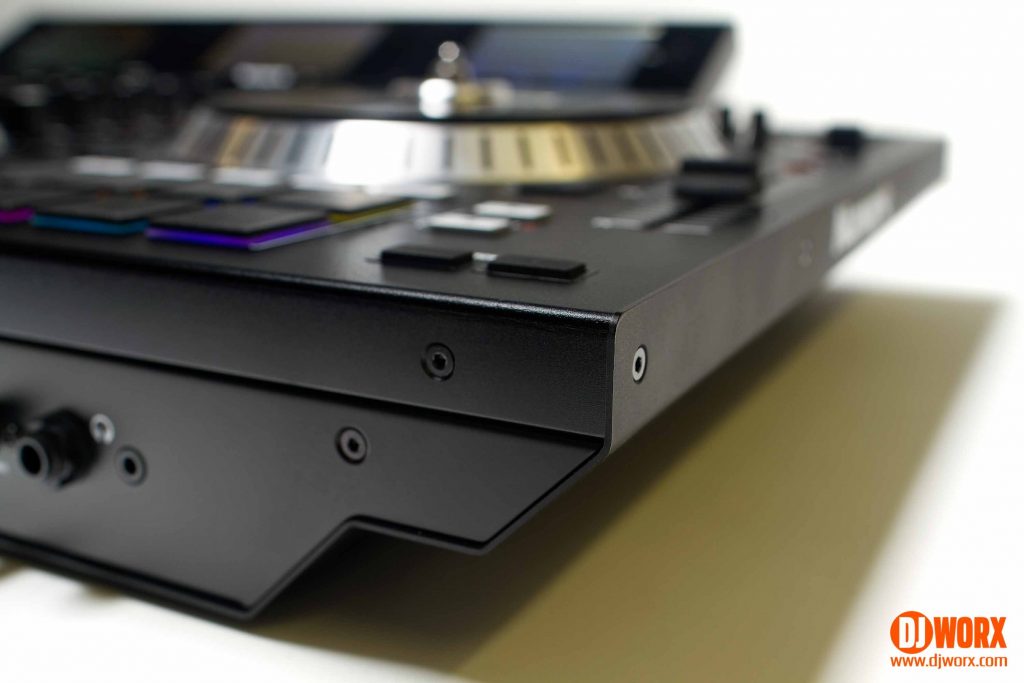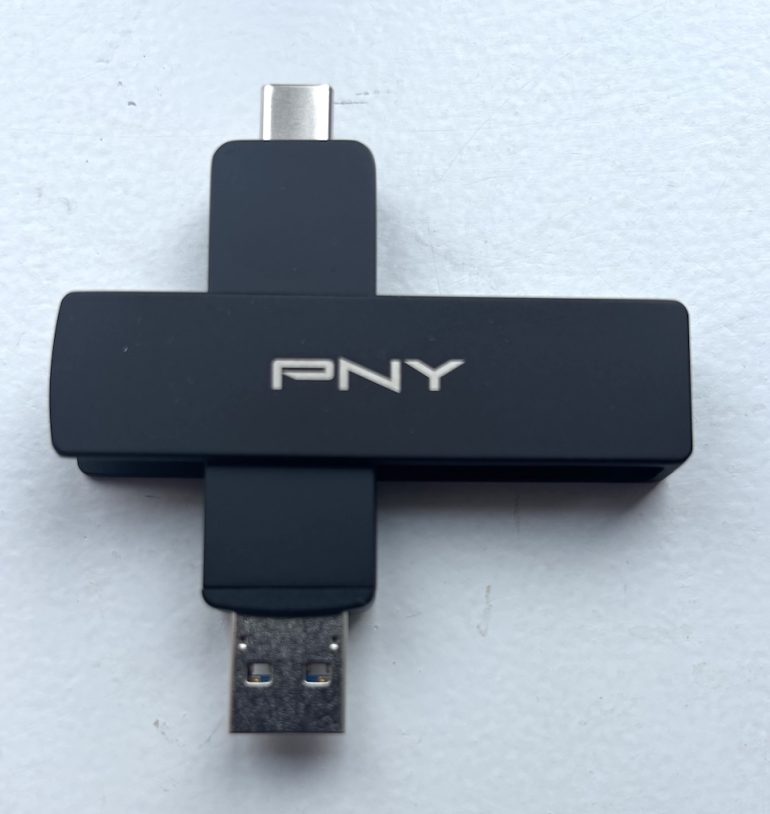LINK: Numark | PRICE: $1499/€1444/£1049 | MANUAL: User Guide
Mark carries out a Numark NS7III review to see if it improves on his favourite controller the NS7II
Table of Contents
INTRODUCTION
Do you remember when Numark floated a trial balloon consisting of an NS7II with built-in screen? Here’s a reminder:

This was all about screens and embedded tech. The screens subsequently appeared in the Numark NV, albeit less grandiose than this incarnation. And the embedded tech is still a pipe dream at this point. But the buzz and outright GAS explosion that followed made Numark think that an NS7II with screens might be a good idea… well I suspect at this point that the NS7III was already in the works.
But the mockup would have been enormous and expensive. So how could Numark add screens to the box and not break the bank? Easy — make a separate box of screens. And that’s what the NS7III is — a reworked NS7II with an additional screen unit. But does the addition of screens make the original better? Let’s conduct an in depth Numark NS7III review and find out.
THE DIFFERENCES
Getting this out of the way first — the obvious difference and the raison d’être of the NS7III is the screen unit. But we’ll get to that in detail in a bit. But let’s cover off the handful of differences in the main units.
Functionally, the NS7III is no different. Check out this GIF overlaying the NS7II with the NS7III:

This being the case, check out my review and Ray’s review for the very best opinion on the original. There’s no point going over it again in detail, not even a little. It’s all in those reviews.
There are a handful of notable differences though, and some you can see while others you can’t. The visual differences are clear — the whole thing has had a bit of a cosmetic rework. While still retaining the black and red colour scheme, the pads have changed, and the overall construction has been revised to make the chassis a tad sleeker and around 2lbs lighter. The shiny finish has gone and been replaced with something considerably more light and fingerprint friendly too.

One under the hood change for the better is class compliancy. So instead of having to wait for Numark to update drivers, the responsibility falls upon the software vendor, in this case Serato, to ensure that everything works. That’s one less weak link in the chain.
That said, I don’t feel it’s enough for existing owners to offload their units to update, not even those with advanced cases of GAS. Without any functionality updates (not even Serato Flips), the NS7III is a II with a cosmetic makeover. And the NS7II can use the new screen units anyway that is separately available.
IT’S ALL ABOUT THE SCREENS
Like the NV before it (and these screens are the same ones), the NS7III is all about the screens. We’ve all seen DJs apparently distracted by whatever is happening on their laptop screen when in reality everything they need to perform is happening on that screen. So it’s makes sense to put the essentials from that screen right in front of you.
ss
Building the screens right into the unit would be cool, there are a heap of reasons why having them as a separate unit makes more sense. But we’ll get to that later. The screen unit is all plastic, and powered by the NS7III itself. It comes with all the necessary USB connections as well as a spare port just in case a punter thrusts a USB drive into your hands to play their new track.




The unit is broken up into three screens — left deck, right deck, and library/waveform screen. At first glance, these are very reminiscent of Serato Remote mini app, and do show similar features. There are two views for each screen — the decks show zoomed and full waveforms, effects controls plus basic track info, and in the middle is the library. Pressing the view buttons switches to another level, where the track info changes to the familiar Serato virtual deck, pitch details and auto loop measures. The middle screen shows a pair of stacked waveforms of the active decks, so if you want four waveforms, it’s back to the laptop screen for you.
Q. How many NS7II owners actually use four decks? Is it such a huge deal to only show detail for currently active decks?
What the screens don’t show are some of the finer points of the pad functions so you’ll still need to refer to the laptop screen for some details. But generally speaking the screens do a great job of keeping your attention where it needs to be. And I really don’t get why the screens also show effects knobs, as they’re sat right above… the effects knobs that show exactly the same thing. Seems like wasted screen space that really is at a premium on these small screens.
At some point, Serato’s technology will evolve so that you’ll be able to design your screens and the information you want to see. For now, enjoy what they’re offering now — it’s really rather good.
POSSIBLE FUTURE?
Coming back to why the screen is a separate unit, it does mean that your expensive investment in an NS7II isn’t wasted as the screen unit is available separately to add to your existing controller. Rejoice!
“Add to your existing controller…” sticks in my mind. If it can be done for the NS7II then why not others? Maybe it can. I mean… it’s just Serato data right? It would be rather nice to use these screens with say a Serato DJ DVS mixer, or to add screens to an existing controller that doesn’t have them. Time will tell.
SO WHAT’S THE NS7III LIKE?
It’s like the NS7II but with less looking at your laptop. Functionally it offers nothing over the previous NS7II. It’s an ever so slightly more polished experience due to the new look, but nothing else has changed.
But the screens do bring focus to your performance. They do offer a selection of things you need to frequently look at, but not everything. So the idea of closing the laptop lid, especially on a capable and complex unit like this just doesn’t fly for me. But at least I’d spend less time gawping at waveforms over there somewhere.
When setting up, the screen unit does rather get in the way of plugging in cables from above. You’ve go to be pretty tall to see over the screens to see the rear of the unit. But other than that, the screens are a valuable addition to what is already an amazing controller.
SUMMING UP
As you might expect, I get to play with a huge amount of DJ gear. But of asked, I have one unit that won my heart almost immediately. The original NS7 was everything I wanted from a controller — two channels, built like a tank and large motorised platters. And then they delivered the four channel NS7II and my life was pretty much complete. For me it brought something to my DJing that so many other units didn’t — pure unadulterated fun.
And the NS7III simply brings focus to that fun, and allows my actions to be more immediate. Not only that, should a crowd be watching, it’s a much better experience for them as well. And in a crowded DJ market, you really do need to be thinking a little more about how you present yourself to the dance floor.
THE BOTTOM LINE
The NS7II was my favourite controller. Now it’s the NS7III. It’s a powerful beast injected with a lot of fun. And if you want the essence of vinyl based DJing world mixed with all that is good in the brave new world, then the NS7III is it. Well for me anyway.
Numark NS7III review GALLERY




















The best controller ever made gets better. I personally think that it is the feel of the vinyl under moving platters that makes this product so special. That feel trumps the weight and anything else that is seemingly negative. Every once in a while we’re reminded that having fun performing is actually the most important aspect of DJing. This is one of those times. Long live the NS7 series… and yes, I secretly wish for an NS10 series.
In before the “Where’s the Traktor mapping?”
Just played for a couple of hours with one at gc. got a “wow” from a couple of monks(orange robes) for some line fader tricks. Sound is great, mixing has never been easier, buttons are good, it’s great, what more can I say.
Here’s what-
It feels like work to use those little screens. There’s not enough info on them, and the position makes it feel like “effort” to look at them.
I applaud Numark for the effort, but again and again and again I ask, collectively to all, why not put the device in the hands of someone perceptive, and see if the are some tragic flaws?
The screens simply DONT work. The need to look at the laptop isn’t diminished one bit.
(And please don’t think I’m bitter just because you asked me to be your west coast rep and work for free for the 1st 6 months. I still get a good laugh from that. I’m on your side. I’m a big fan of the NS7 and Numark.)
It’s an effort to look up a few inches? Granted, the screens are a bit big print, but they show enough to stop casual glances at your laptop, at least that’s my experience anyway.
One other thing Steve — any chance that you could sign up for a Disqus account and stick to a single name? All the aliases get confusing for people. It’ll help the community. Ta very much.
I use the S8 regularly, and I still need my computer screen. It’s not that it’s effort to look at the screens, it’s that there isn’t enough information. I have stopped casual glances, though, and do a lot more from the device itself.
But I can’t search, or if I search from my computer I still haven’t figured out how to cancel the search. And I am limited with deck information. That sort of stuff.
“it’s that there isn’t enough information” yesss ! And so when I look there it feels like effort, because my brain is working to find a reason why I’m looking here, but can’t come up with one, that’s why I said effort; mental effort, not physical
To me the most interesting bit is if it’s possible to get the screens to work with other equipment. If I knew I could get it to work together with my dvs setup, sl4, dicers and hak360 (or sometimes my vci 380 renamed in midi setup to get access to the pads with the sl4), then I would put in an order for the screen today.
Perfect size, enough info for me on them. I bet the would sell loadsto people that wants to get rid of Serato face.
Why use screens at all – why not use an iPad – Denon had the best solution – while engine was in need of an update, it did what it was supposed to. Tablets are the best extension to existing hardware…. Look at Personsus and how they’ve implemented it. Deion was on to something there….. hopefully In Music is bright enough to use that technology.
I totally agree, I was thinking the exact same thing!!
i’m convinced the only tech that is ever going to really be worth bothering over is figuring out some way to project the screen onto a clear vinyl from under the deck. nope, got no idea on how to do it, but i’m sure that “where the music used to be”(i.e. on the record) is where to put the new digital info.
I was thinking in it time ago even I wondered a technical solution but it will require an expensive design…
yea, I don’t know how it’s going to happen, but it will. the platter/vinyl is where your eye “wants” to go.
there are planty of ways to do this
A smart vinyl with oled screen in the middle or this version, where the stuff is projected to the viny
youtube.com/watch?v=2719q45YW-4
Yes, when I saw that projection system, I was amazed.
Since the cdj 2000, is one of my favorite “non vinyl scratchers” (they really scratch great) I tinker around with them a lot, and I wonder if the NS7III might have been better served with a screen similar to those.
OR, take this “strip of screens” thing and run with it. Put the computer into it, make a solid connection system on the right and left sides, and put a projector in it. Browsing in the screens, waveforms projected onto the decks.
“Denon had the best solution”…
No, I disagree. I much prefer a standalone unit to be 100% standalone.
They were headed in the right direction with the HS5500, but for some odd reason went back to basic screens on the 2900/3900 coupled with the need to own an iPad and run an app in order to see your track library.
Pioneer took the onboard idea and ran with it. CDJ-2000 onwards – screen built in. I sincerely hope Denon realise that’s where they need to go with any new kit that may be coming later this year.
Ain’t nothin goin on but a history, yeah. It’s alright. Don’t panic!
Class compliance? Even the platters?
That usually means the audio interface.
Sadly.
Class compliant is is something that came about by Apple and Microsoft, after audio companies like Numark went out of its way to make hardware work with their operating systems before anyone else, thus requiring drivers to work around previous limitations in those said operating systems. By making hardware meet the standards these OS providers have recently created, the need to have drivers is eliminate, thus insuring that when an OS update occurs, the hardware provider does not need to completely rewrite drivers for a customer base to use the now OS with hardware. Platters on the NS7 on the other hand were created with very complex algorithms, and purpose built in colabiration with Serato during a multi year development process. Other capable software providers have of course made them work as well, but the best experience will always be team of engineers that collaborate to make them work in the first place.
I know what is class compliance but my question was more focused to “midi” class compliance due it will mean the possibility of platter assignement to iOS apps (djplayer) or traktor (historic user request) which in the Dan comment seems not occurring, sadly.
I think I answered the historic user request issue in what I said about other capable software….. It is also time and effort for any software company to make this work. iOS is less an issue though for the developers as it is in the iPad processing power. These wheel are sending out constant information unlike static wheels that’s only put out info when moved or touched.
Class compliance midi means midi output without any driver. Gàbor could decode the regular signal if the gadget “connects” with the ipad and for this it needs to be class compliance… Apple blame in this case. Maybe it sends HID or something reliable but it needs to be Apple compliant in any way or hardcoded (ala Z1/S2,4mk2 with traktor).
Other manufacturers made the translator but it is not related with class compliance, it is related with inverse engineering.
Limitations by hardware itself but hey! Maybe Gàbor could bring some light about the topic and make magic.
I sincerely wish you all the success in the world with the III. I only want to help, and hope I don’t come off as a naysayer.
Steve, didn’t see it that way. To your question, Apple requires the usb to draw only 100ma. Even though the ns7 is obviously not buss powered, the communications chip is hard set usually at 500ma. Regarding the platters, the ns7 puts out 3600 messages over midi with every revolution of the platter. That times 2 platters. No iPad was ever designed to process that fast.
If I were a betting man, I’d still put my money on Gabor being able to make it work.
Very nice unit. I own one. Just wish that it had standalone capabilities. It has a USB port. But that’s just for your USB drive to save you from using a USB port on your laptop,
Yup I own the NS7II and I have to say it is by far the best controller on the market.
I have been dealing with Numark products since 1986 and I have to say most of there stuff works almost like a technic 1200..key word “almost” there faders aren’t the best. That why I equip tall my Numark Mixers with Innofaders.
The only little thing I don’t like about my NS7ii is that it does not support djayPro by Algoriddims..I spoke with the CEO Karim and he told me they are having trouble with the jog wheels.
I love my NS7ii it’s awesome!
If Algoriddims ever does get this unit to work with djayPro then I will say goodbye to Serato forever.
The platters are the problem with all other software. It’s proprietary to Numark, so implementing the platters in Traktor, MixVibes, etc. requires custom code to address. IIRC, Virtual DJ wrote custom code to support the NS7 series…
If there’s one thing we can all be sure of, it’s that Gabor Szantos CAN make those platters work with DJ Player.
I haven’t even connected the iPad to my ns7 in a while, it used to say “device draws too much power”
Djay desktop app right? Could someone confirm this unit is cck compatible? Anyone tried cck+powered usb hub?
Yes Djay Pro Mac OS version not the iOS.
Why djay pro over serato? I have both and prefer serato.
djay Pro or djay in general was created by programmers who Worked for Apple and know the OS you hardley ever find bugs in the software and updates are usually out a day after the Mac OS updates come out. I had to wait three weeks for Serato to work with El Capitain and it was still buggy I downgraded back to Yosemite.
Plus djay has built in Spotify ,it’s a lot more stable. iTunes library loads faster.
Plus djay’s interface is less intimedating and easier to manage.
I can go on for days but I’ll stop there.
I have both too only because my NS7ii doesn’t work with djayPro
Maybe some day…wishful thinking ;)
So like these tvs they are showing at CES, where it’s just a flat sheet. How bout the surface of the ns7 being the screen.